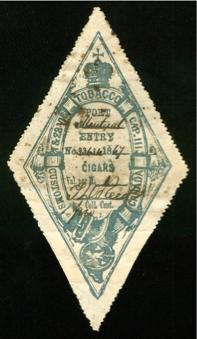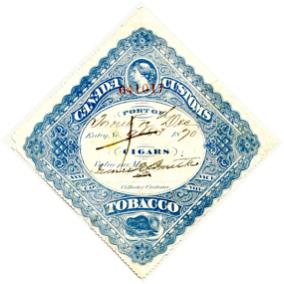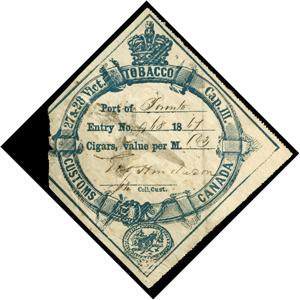

Dating Canadian Boxes
Using Excise and Import Tax Stamps
A National Cigar Museum EXCLUSIVE
(c) Tony Hyman with help from Chris Ryan, John Harper and Lee Brandom.
Canadian cigar stamps first appear in 1864 and were used until 1974, when Canada became the last country to quit using tax stamps on packages of cigars. As in the U.S., the five most prevalent denominations are 5, 10, 25, 50 and 100 but Canadian stamps are also occasionally issued in 2, 3. 4, 6, 8, 20. 30, 200 and 500. New designs were issued far less frequently than in the U.S. making Canadian stamps much less useful than their U.S. counterparts which for 30 years changed annually.
The Canadian excise tax stamp issues of 1883, 1897, 1915, 1922 and Series C (used 1935-1960) are those most likely to be found on Canadian cigar boxes. Stamps do not absolutely date Canadian boxes because cigar makers were allowed to use up old stock after new stamps were issued, often forestalling the printing of some denominations for many years after the laws changed.
This exhibit includes many Canadian excise and import tax issues you are unlikely to ever see on a box. Pre-1890 Canadian cigar production was low (compared to Europe, Cuba or the U.S.), plus the Canadian Inland Revenue Act of 1880 sternly warned retailers to destroy cigar boxes that have traces of a Canadian tax stamp. Law-abiding literalists made early Canadian boxes very scarce today.
Dating Canadian Caution Notices
based on research provided by Dr. Sheldon Posen, Curator,
Canadian Museum of Civilization and his consultants.
The Canadian Inland Revenue Act of 1880 contained no requirement for a Caution Notice or ID similar to those required in the U.S. after 1868. The Act did contain strict stipulations about removing the revenue stamp and destroying boxes that had traces of a stamp. Law-abiding literalists made early Canadian boxes very scarce today.
Caution notices were introduced in 1883 by Inland Revenue, 46 Vict., Chapter 15.
The wording of the law and the Caution Notice is close (but not identical) to the 1880 U.S. version of the law.
267. Every manufacturer of cigars shall securely affix by pasting on each package containing cigars manufactured by or for him a label, on which shall be printed the number of his manufactory, and the number of the Inland division in which his manufactory is situated, and these words: “Notice: —The manufacturer of the cigars herein contained has complied with all the requirements of the law. Every person is directed to open this package in such a manner as to break the stamp, and is cautioned not to use either this package for cigars again, or the stamp thereon, nor to remove the contents of this package without destroying the said stamp, under the penalties provided by law in such cases.”
The law was rewritten in 1890, changing the wording of the Caution Notice, numbering each provision, thus making it distinctly different from that on U.S. made boxes of cigars. The new wording went into effect in July, 1891, but was permitted any time after November 1890. Canadian boxes with the earlier version Caution Notices are seldom found today.
The following form of caution notice is prescribed for use on cigar boxes:—
‘Factory, No. …………Inland Revenue Division No…………… [after 1921 “Port”]
Notice: The manufacturer of the Cigars herein contained has complied with all the requirements of the law. The following caution is to be strictly observed under the penalties provided by the Statutes of Canada:—
1st. This package is to be opened in such a manner as to break the Stamp.
2nd. The package is not to be used again when the present contents are removed.
3rd. The contents are not to be removed except for immediate sale; and
4th. When the package is empty the stamp and package must both be destroyed.
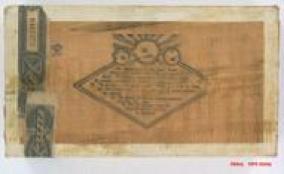
Sec. 93. This label for all cigar boxes is to be not less than three inches in length and two inches in width; or if made in circular or oval form, it shall cover not less than six square inches of paper and be of a size sufficient to contain, in addition to the caution notice prescribed in plain, open, and legible letters, these facts: (1) the number of the manufactory, and (2) the number of the Inland Revenue Division.
Later in the Act, factory identifications similar to those required in the U.S. since the 1860’s were introduced:
Article 9
Sec. 166 The law provides that there shall be burned, stamped, indented, or impressed into every box containing cigars, in a legible and durable manner, the registered number of the factory, the number of the Inland Revenue Division in which the factory is situated, and the number of cigars contained in each box: the number of cigars contained in each box may, however, if desired, be stenciled on the surface of the wood or other material of which the package is made; but the registered number of the factory, and the number of the Inland Revenue Division, must be burned, stamped, indented, or impressed into every box, as required by law …
Boxes with 1883 stamps (1883-1897) are found with both early and later Caution Notice wordings on paper labels. Boxes with 1883 stamps are also found with Caution Notices printed directly on the box as a result of a law change some time during the late 1880’s or early 1890’s. All Canadian cigar boxes with 1897 stamps have their Caution Notices directly printed on the box. Direct printing of the Caution Notice was not allowed in the U.S. until 1910.
Caution Notices in Canada were no longer required sometime between 1934 and 1939, possibly at the same time Series C revenue stamps were introduced in 1935.
Canadian tax officials were flexible regarding decorative borders around Caution Notices, unlike the U.S. where size and form were specified exactly after 1910. Decorative elements include horseshoes, maple leaf, beaver, elk, chains and fleur de lys as well as various geometric figures.
1864 Excise & customs issues
The customs stamp for 1864 is a similar square printed in blue. Text differs slightly, includes the word “Port” followed by space for port to be handwritten or stamped.
Customs stamp not in NCM collection. Seen through the courtesy of Chris Ryan and John Harper.
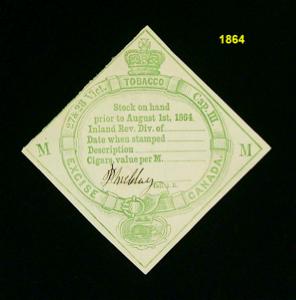
1864 Issue, later printings
Stamp on right not in NCM collection. Seen through the courtesy of Chris Ryan and John Harper.
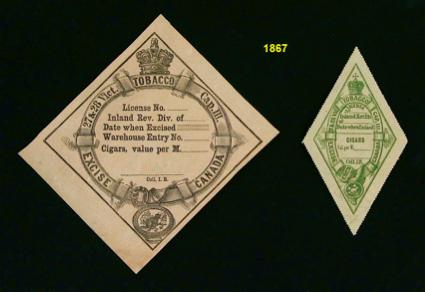

Stamp on right seen through the courtesy of Chris Ryan and John Harper.



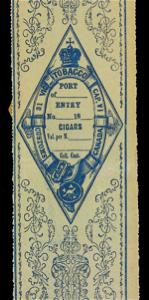

1881 Excise & customs strips
Between 1868 and 1880, Canadian stamps changed only slightly. In 1881, a new design was created. Stamps were issued blank as well as imprinted with the province in which taxes were paid. Different rates were charged based on the origin of the tobacco used, the color of the stamps indicating the tax and tobacco origin. Green indicated cigars made of all domestic tobacco, black was used for cigars made in Canada of imported tobacco. Between 1881 and 1883 red stamps were used on cigars going into bonded warehouses with duty unpaid. Blue remained the color for imported cigars, but the stamp had a slightly different design, including the words “Canada Customs” in an arc. This is the last Canadian stamp marked specifically as a Customs stamp. A yellow stamp was also issued to indicate sample boxes opened in the factory. The story of how these yellow stamps were used can be found at the end of this stamp chapter.


1883 Removed from Bond
If you find either of these 4” long stamps on a box, please contact me.
1883, 1885 & 1887 Excise strips
ALL STAMPS TO SCALE. YELLOW DATES ON STAMPS ARE FOR YOUR REFERENCE. THEY ARE NOT ON THE ORIGINAL STAMPS.
In 1885 a stamp for boxes of 10 cigars was authorized in black, blue and green, followed two years later by blue and black stamps for boxes of 3 and 6. Why a 12” stamp was needed for a pack of 3 cigars and a 15” long stamp for a pack of 6 cigars is not clear.
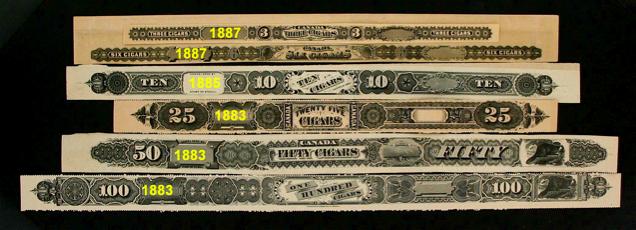

1897 Excise strips
The 6 is missing from the illustration as I don’t own one to photograph.

The 50 is the most frequently seen 1897 issue, here shown in all four colors. Red
stamps were then used on boxes of cigars made of foreign and domestic tobacco, mixed to government specified proportions. After 1908, only black stamps were printed and colored stamps were withdrawn and believed to have been sold to collector[s]. Because they continued in use, black stamps are difficult to find in mint condition.


1915 Excise


This is incorrectly cataloged by Brandom as first issued in 1922.
Until 1926 cigar makers were charged extra for buying small denomination stamps.
1922 & 1924 Excise strips
One of the most often seen stamps is the issue of 1922, tho the 100 is dated 1924. Size varies slightly from 6” to 6 1/4” in length.
Yellow dates are not on the original stamps.
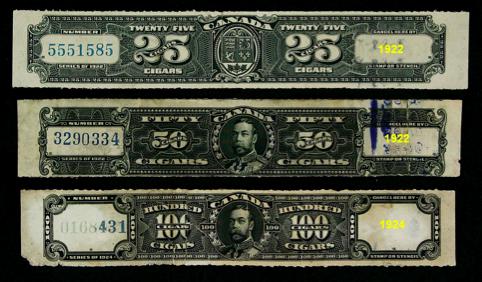
1925
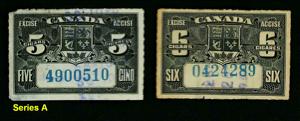
1935 Series C
The most commonly seen cigar revenue
stamps are the undated Series C strips authorized in 1935 in 25, 50 and 100 denominations. The 100 appears to have not been issued until a few years later. Series C was used until 1960 (or until stocks ran out). The 50 and 100 have the same design as the 25.
Smaller denominations were issued as colored verticals and black horizontals. Beginning in 1938, these small stamps were introduced as stocks of the 1922 and 1925 design were exhausted. Canadian stamp collectors report dates as late as 1948 for the first appearance of some issues. The black and colored varieties appear to have been used simultaneously.

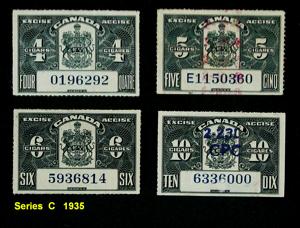

1952 Provisional strip
In 1952, Series C stamps for boxes of 25
were overprinted to accommodate boxes of 20 or 30 cigars. These were used for eight years until 1960 (or until stocks ran out).
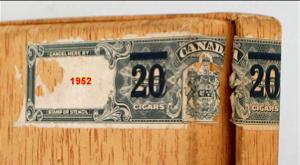
1960 Strip

1965, 1971 & 1973 Small verticals

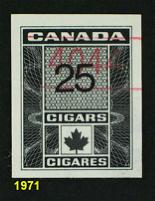
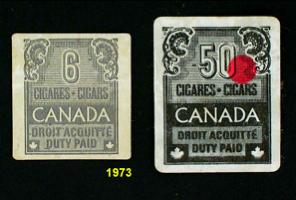
Yellow Stamps for Sample Boxes
Liberally lifted from Lee Brandom
Canadian handling of sample boxes was very different than in the United States. Lee Brandom in the First Supplement to his catalog of Canadian tobacco stamps, explains why yellow stamps and specially marked sample boxes are hard to find:
”Direct access between a manufactory and a retail outlet is not permissible. Nor is a manufacturer permitted to have part packages or packages with broken stamps in the manufactory except under special conditions. However, a cigar manufacturer was allowed to have ‘samples’ to hand out to prospective customers. Excise duty had to be paid on such cigars, and the special stamp, yellow in color [1st issued 1880: Tony], was applied as a control and to identify sample boxes from other stock. As the number of small manufacturers declined, fewer stamps for sample boxes were needed, and the specially colored stamp was discontinued [exactly when is unclear, but yellow stamps are not listed in 1883 or later: Tony]. However, until the 1940’s at least, manufacturers were permitted to have up to three sample boxes open at one time in the manufactory. These samples would be taken from regular stamped stock to the Excise Officer, who would initial and date the stamp [stamp issues of 1883-1897 have been found so inscribed, but no later stamps have been cataloged with that marking: Tony]. When the box was used it would be returned to the Excise Officer and destroyed. A replacement box would be released if required. Sample boxes were in the 25 denomination only; and not more than three boxes of samples were allowed in the manufactory at any one time.”
Other Canadian Laws
Like their U.S. counterparts, every Canadian box has an I.D. consisting of a government assigned factory number and the tax district and the number of cigars in the box. Between 1867 and 1921 Canada was divided east to west into tax districts called Inland Revenue Divisions (abbreviated IRD). After 1883 a code number was added to the IRD to identify specific cities or regions. IRD 26, for example, was Toronto. An ID might read Fact. 12, IRD 26, 50.
Sometimes the ID information was shortened to three numbers. If a cigar box is marked
6-17-25, it’s read as Factory 6 in IRD 17 (S. Davis & Sons, Montreal) and a box of 25 cigars. The Canadian Museum of Civilization has identified many of the IRD-city combinations:
IRD 6 St. John
8 Quebec
9 Trois Rivieres
10 Sherbrooke
14 L’Epiphanie
17 Montreal
18 Brockville
22 Kingston
26 Toronto
27 Waterloo
28 Kitchener / Berlin / Galt
30 Hamilton
31 Woodstock / Brantford
32 London / St.Thomas
33 Stratford / Listowel
34 Chatham
36 Winnipeg
37 Victoria
38 Vancouver
39 Edmonton
After 1921, IRD’s were renamed “Ports” and a new system developed. Each province was assigned a letter from east to west. A was assigned to Nova Scotia, B to Prince Edward Island, C to New Brunswick, D to Quebec, E to Ontario, F to Manitoba, G to Saskatchewan, H to Alberta and I to British Columbia. Within each province numbers were assigned to cigar making centers as well as factory numbers to individual makers. Within the province of Quebec, for example, 10D was Montreal whereas 13D was Quebec. After 1921, the ID on a box of 50 cigars made in Montreal by S.Davis & Sons would read Fact. 6, Port 10D, 50.
BASIC DATING USING A CAUTION NOTICE
Look at the bottom of your Canadian cigar box.
Is there a Caution Notice? If yes, it’s before 1935 or so. If not, it’s after 1936 (more or less).
Does the ID - Caution Notice use the initials IRD? If so, it dates 1883-1921 (or slightly later). Does the ID - Caution Notice use the word Port? If so, it dates between 1921 and 1935 (more or less). Always remember, dating Canadian boxes using their laws and stamps is much less accurate than dating U.S. made boxes, where latitude of enforcement was rarely more than two or three months as opposed to “when stocks run out.”
As in the United States, if a cigar maker shut down, the factory number could be, and frequently was, reassigned.

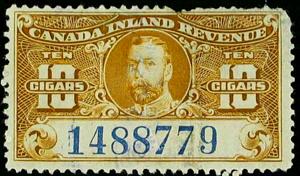
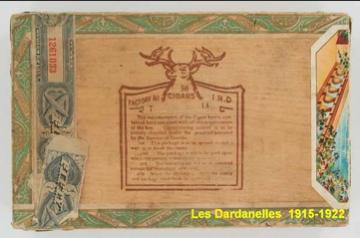

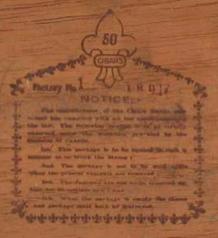
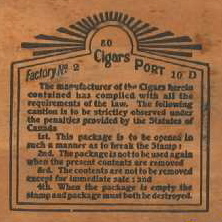

Only three of these yellow-colored 1883 sample stamps are known. The yellow color wouldn’t reproduce so is shown here in black. Stamp seen courtesy of Chris Ryan & John Harper





